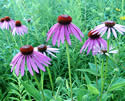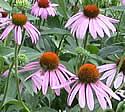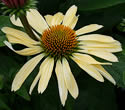Echinacea purpurea (Eastern Purple Coneflower)
| Also known as: | |
|---|---|
| Genus: | Echinacea |
| Family: | Asteraceae (Aster) |
| Life cycle: | perennial |
| Origin: | South/Eastern US |
| Habitat: | part shade, sun; moist rich prairie, fields, woodland edges |
| Bloom season: | July - October |
| Plant height: | 2 to 4 feet |
| Wetland Indicator Status: | none |
| MN county distribution (click map to enlarge): |  |
| National distribution (click map to enlarge): |  |
Pick an image for a larger view. See the glossary for icon descriptions.
Detailed Information
Flower: 
![[photo of Eastern Purple Coneflower]](/udata/r9ndp23q/pd/echinacea-purpurea-17-t.jpg) Flowers are single on end of stout stem, with 15-20 rich pink to purplish rays (petals), each 1½ to 3 inches long and ¼ to ¾ inch wide, with 3 notched teeth at the tip. Rays grow out and up, curving down with maturity. In the center is a large orange-brown disk, round to conical in shape, covered in tiny disk flowers with yellow pollen.
Flowers are single on end of stout stem, with 15-20 rich pink to purplish rays (petals), each 1½ to 3 inches long and ¼ to ¾ inch wide, with 3 notched teeth at the tip. Rays grow out and up, curving down with maturity. In the center is a large orange-brown disk, round to conical in shape, covered in tiny disk flowers with yellow pollen.
Leaves and stem: 


![[photo of leaves]](/udata/r9ndp23q/pd/echinacea-purpurea-6-t.jpg) Leaves are mostly alternate, sometimes opposite, 3 to 6 inches long, 1 to 3 inches wide, lance-like, broader at the base, tapering to a point, stalked, becoming smaller and stalkless as they ascend the stem. Leaves have serrated edges and 3 or 5 distinct veins along the length. Stems and leaves are smooth or hairy to varying degrees. Stems are mostly unbranched, typically brownish green.
Leaves are mostly alternate, sometimes opposite, 3 to 6 inches long, 1 to 3 inches wide, lance-like, broader at the base, tapering to a point, stalked, becoming smaller and stalkless as they ascend the stem. Leaves have serrated edges and 3 or 5 distinct veins along the length. Stems and leaves are smooth or hairy to varying degrees. Stems are mostly unbranched, typically brownish green.
Notes:
A native of eastern moist to mesic prairie, Eastern Purple Coneflower is the species typically found in the nursery trade and many colored variants are becoming more common. It can make for thick showy stands in the garden but is subject to aster yellows, a phytoplasma spread by leafhoppers that affects a large number of herbaceous species and causes stunting and yellowing of the foliage and blasting of the flower heads. Affected plants should be pulled and can be left in the garden as they pose no risk to healthy plants after uprooting. Eastern Purple Coneflower is not native to Minnesota, but is common in roadside plantings, both urban and rural, as well as increasingly a garden escapee. Its flowers are similar to our native Echinacea angustifolia (Narrow-leaved Purple Coneflower), which has mostly basal leaves that are long and narrow.
Native Plant Nurseries, Restoration and Landscaping Services ↓
More photos
 Eastern Purple Coneflower plants
Eastern Purple Coneflower plants garden grown Eastern Purple Coneflower
garden grown Eastern Purple Coneflower Eastern Purple Coneflower cultivar
Eastern Purple Coneflower cultivar
Photos by Peter M. Dziuk taken in Winona County and in private garden in Anoka County.
Comments
Have you seen this plant in Minnesota, or have any other comments about it?
on: 2019-09-24 17:39:50
Several plants have established themselves in an old field and along a driveway. They are escapes from cultivated plants in a flower garden and are slowly spreading with about two dozen plants this year.
on: 2020-03-30 06:01:51
This nonnative species is loved by deer and woodchucks which eat them right to the soil line. Never had aster yellows on the plants but commonly have had problems with mite infections which look like aster-yellows in the way they deform the flower heads (called Fasciation). Does self seed on open ground and is loved by seed eating birds in winter.






